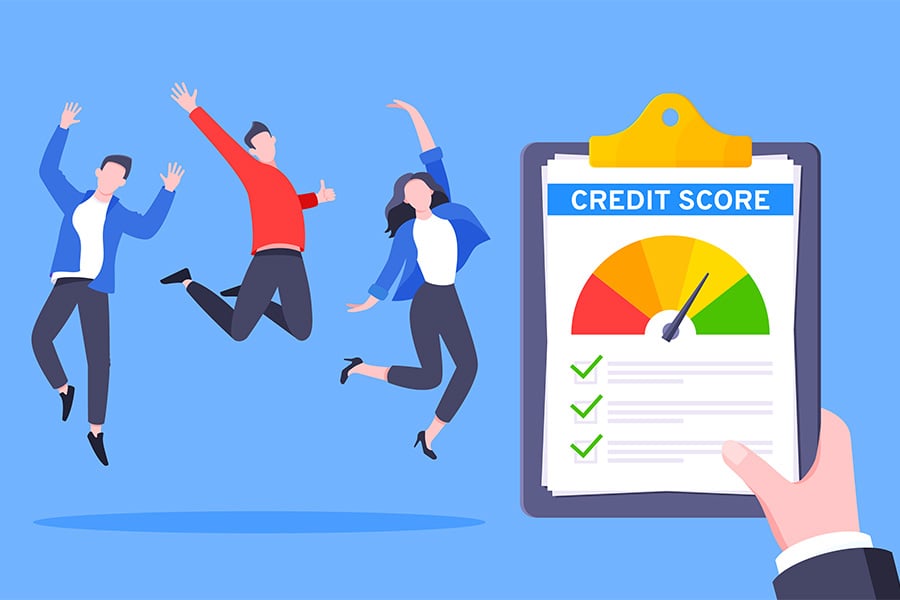Are You Ready to Improve Your Credit?

Getting a higher credit score doesn’t have to be complicated or confusing. Once you understand how your credit score is calculated and, more importantly, how your daily decisions make it go up or down, you’ll be on your way to increasing your credit knowledge, confidence, and ultimately, your credit score.
But there’s no quick fix. Building and maintaining your credit score won’t happen overnight, but it will happen if you practice patience, take time to expand your credit knowledge, and stick to your plan for success. To increase your creditworthiness—a lender’s willingness to trust whether you will pay your debts, such as a credit card, auto loan, or mortgage—here are five steps you can take.
Changing your credit score is a journey.
By following these steps, you can get to your destination of improvement.
1. Learn what influences your credit score. Five major factors play a role in determining your credit score: Credit Mix (the types of credit you have, such as credit cards, student loans, and car loans), Amounts Owed (how much of your available credit you are repaying), Credit Length (the age of your credit accounts), Payment History (your track record of making payments on time), and New Credit (how much new credit you are applying for).
2. Pay your bills on time. Even if it’s just a few days past the due date, late payments will hurt your credit score. To help avoid this situation, set up automatic payments with your bank or credit union and credit card company, so your payments are always on time.
3. Lower your credit utilization rate. Using too much of your available credit can lower your credit score. A good rule of thumb: keep your total credit utilization less than 30%. For example, say you have a retail credit card with a limit of $1,000 and two bank credit cards with limits of $500 each. That means you should aim to keep your total utilization below $600 across all three accounts.
4. Check your credit reports at least every year. Credit experts recommend reviewing your Experian®, Equifax®, and TransUnion® credit reports every 12 months to check for errors. While negative credit information, such as repossessions and bankruptcies, stay on your credit report for seven or more years, you may spot and dispute errors or signs of identity theft or credit card fraud, both of which can negatively impact your credit score.
5. Close accounts with caution. If you pay off an account or have an old account that you no longer use, think twice about closing it. Depending on how much available credit you have, this action can increase your credit utilization, lowering your credit score.
To learn more about how to achieve your financial goals with ProtectMyID®, visit AAA.com/IDTheft.
Think of ProtectMyID as roadside assistance for your identity. With a suite of credit features such as Credit Monitoring, VantageScore1® Tracker, Score Variance Alerts, and Experian CreditLock, with ProtectMyID, you’re in control of your credit.
1VantageScore 3.0, with scores ranging from 300 to 850, is a user-friendly credit score model developed by the three major nationwide credit reporting agencies, Experian®, TransUnion®, and Equifax®. VantageScore 3.0 is used by some but not all lenders. Higher scores represent a greater likelihood that you’ll pay back your debts so you are viewed as being a lower credit risk to lenders. A lower score indicates to lenders that you may be a higher credit risk.
There are three different major credit reporting agencies, Experian, TransUnion, and Equifax that maintain a record of your credit history known as your credit file. Credit scores are based on the information in your credit file at the time it is requested. Your credit file information can vary from agency to agency because some lenders report your credit history to only one or two of the agencies. So your credit scores can vary if the information they have on file for you is different. Since the information in your file can change over time, your credit scores also may be different from day-to-day. Different credit scoring models can also give a different assessment of the credit risk (risk of default) for the same consumer and same credit file.
There are different credit scoring models which may be used by lenders and insurers. Your lender may not use VantageScore 3.0, so don’t be surprised if your lender gives you a score that’s different from your VantageScore. (And your VantageScore 3.0 may differ from your score under other types of VantageScores). Just remember that your associated risk level is often the same even if the number is not. For some consumers, however, the risk assessment of VantageScore 3.0 could vary, sometimes.






